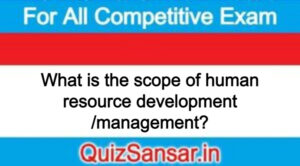
What is the scope of human resource development /management?
What is the scope of human resource development /management?
Or
Explain the scope of personnel management.
Ans.
Scope of Human Resource Development
The Aristotelian saying is worth quoting in relation to the scope of human resource development. Aristotle said, “It is as natural for a human being to develop and achieve his full potential as it is for an across to grow into a majestic oak tree.” Organisation faces the challenges of a competitive environment. Human resource development pays attention on the enabling people to self-actualise through a systematic process of developing their existing potentials and creation of new ones, unfolding the tapping potential capabilities of people both in the present and for the future.
The scope of human resource development is wide because its objective incorporate the following-
1. Providing a comprehensive framework for the development of human resource in the organisation.
2. Enhancing the capability of an organisation to attract, retain and encourage talented candidates.
3. Developing a climate for employees to discover, develop and use their full capabilities for the organisation.
4. Facilitating systematic generation of information on human resources for manpower planning, career planning and development planning.
Human resource development systems and efforts contain following functions to achieve the above objectives-
1. Manpower planning, development systems career planning etc.
2. Training related with the present and future requirements.
3. Reward system to generate a climate of excellence in work and collaboration.
4. Performance appraisal and assessment of potentials of employees to determine their developmental needs through feedback and counselling system.
5. Organisation development to develop the organisational climate and make it more productive and satisfying.
Indian Institute of Personnel Management (1.I.P.M.) has described the scope of personnel management as follows: (i) To determine personnel policies, (ii) To determine the methods of recruitment, training, placement and promotion etc. (iii) To determine the wage system and the conditions of employment. (iv)To provide good working conditions and facilities to the workers and employees. (v) To establish harmonious relations between labour and capital.
Strauss and Sayels have described the following functions: (1) Recruitment and selection. (ii) Job analysis, job description and job evaluation. (iii) Compensation. (iv) Maintenance of personnel account (v) Welfare programmes. (vi) Specialised services. (vii) Programmes of education and training. (viii) Labour relations. (iv) Public relations. (x) Personnel planning and evaluation.
According to Dale Yoder, the scope of human resource management is very wide. It consists of the following activities:
(1) Setting general and specific management policy for organisational relationships and establishing and maintaining a suitable organisation for leadership and cooperation.
(2) Collective bargaining, contract negotiation, contract administration and grievance handling.
(3) Staffing the organisation, finding, getting and holding the prescribed types and number of workers.
(4) Aiding in the self development of employees at all levels providing opportunities for personal development and growth as well as for acquiring requisite skill and experience.
(5) Developing and maintaining for workers by providing incentives.
(6) Reviewing and auditing manpower management in the organisation.






